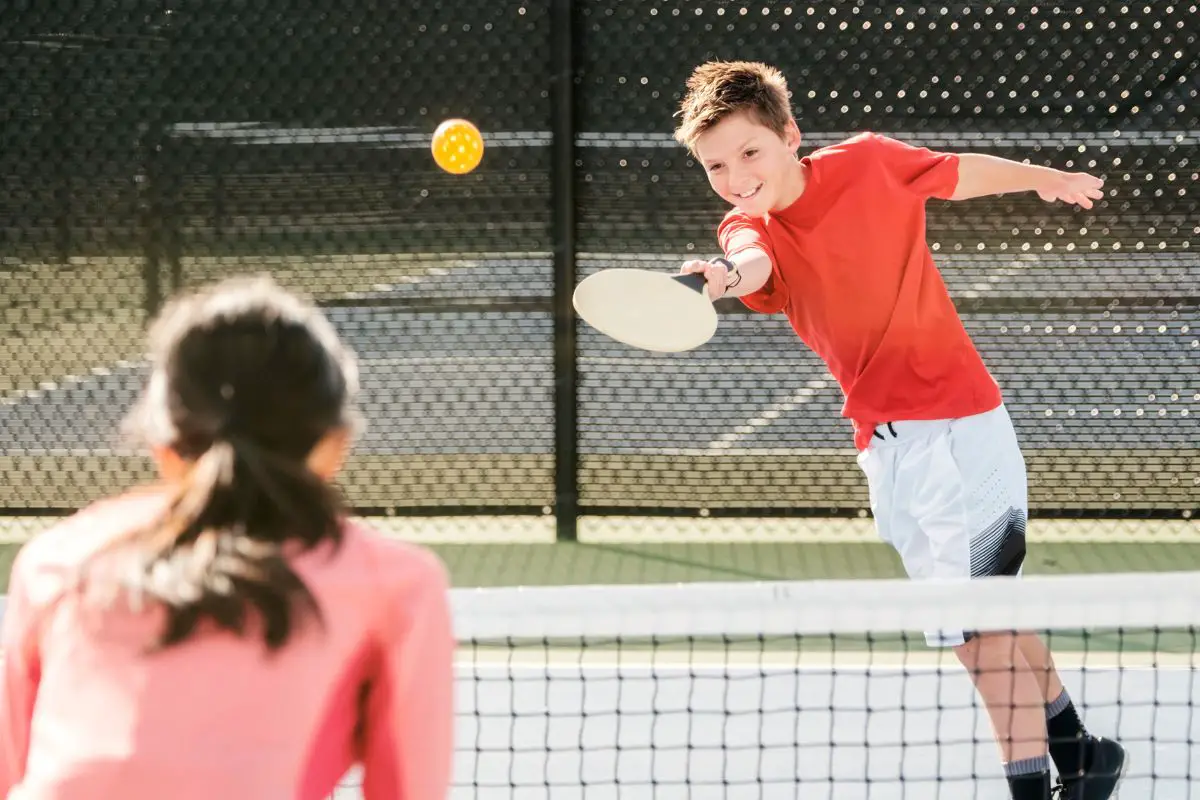If you have never played a racket or paddle sport beyond a table tennis rally on holiday or when you are having a drink, the term forehand may not mean much to you.

In fact, a forehand is a way of hitting a ball with your racket or paddle, and is probably the most common and basic way to hit the ball, but also one of the most effective and powerful – whether you are playing pickleball, tennis, or even table tennis.
In today’s article we are going to cover what a forehand is, why they are used, the benefits of using a forehand shot, and ultimately how to hit a forehand.
Keep reading to learn more about pickleball, forehands, and more!
What Is A Forehand?
Fundamentally, in any racket sport, but also in pickleball, your racket will have two sides, the palm and the back, like your hand.
If you put your dominant hand out, you will notice your own palm faces inward, while the back of your hand faces out.
This is the same with a racket, and a forehand would commonly be described as a hit with the palm of your racket, and a backhand would be a hit with the back of your racket.
Regardless of if you are left or right handed, the forehand is most commonly the best, or most powerful, shot you will have.
For example, if you were going to slap someone instinctively you would probably use a forehand, as this feels most natural, and if a ball is coming at you your forehand is similarly the ‘go-to’ shot.
A backhand is more tactical and works better in different situations.
Why Use A Forehand?
In many ways, the forehand is the most natural shot.
Consider a singles game of pickleball, the likelihood is that your opponent will be probably diagonal to you on the court, anticipating a forehand serve.
When this serve comes you will naturally return with a forehand.
Put simply, if you are trying to have a rally, rather than beat a player with a clever shot as you might in a competitive game, the forehand is the natural shot to make, as your opponent mirrors you they will return with the same forehand, the latter hit being most conducive to a rally.
In other ways, a forehand is most likely your most powerful hit as it comes from your dominant hand.
In a competitive setting, most players will have a strong forehand naturally, while you have practice to get a good backhand.
This said, if your opponent is completely out of position your forehand is an easy shot to make.
If you have good accuracy as a more adept player, you may hit a ‘drive’ which is just a hard forehand.
Or you may choose to ‘dink’ the ball so that it lands in front of the opponent, without them reaching.
Finally, you could hit a volley if your opponent is too close to the net, hitting the ball over their head but still within the confines of the court.
In comparison, if a forehand is best for when your opponent is out of position, a backhand is the best choice if you are trying to score by hitting the ball where your opponent can’t get to.
A forehand catches an opponent out of a regular position, while a backhand would catch them out when they are following a regular position.
How To Hit A Forehand?
First things first, these steps will describe how to simply return a ball with aforehand, rather than any game winning shot.
When you know how to accurately return the ball to the person who hit it to you, your forehand game will naturally improve.
1. You should be standing with legs slightly apart, knees slightly bent, ready to receive the ball with eyes on your opponent.
Your shoulders should be parallel with the net.
Try to think about the weight of your racket in your hand, how your shoulders can swing with your hips, how quickly you might move should you need to.
2. As the ball comes towards you, your dominant hand should arc backwards, what you might call a backswing.
If your racket is above your hips in the ready position, you want it to arc below your hip and then back up above the hip.
3. Naturally, the foot on your dominant side should also move back in sync with your backswing, so that your dominant side is ‘open, but your non-dominant foot and shoulder should still be facing the net.
4. Next your back wing should enter a foreswing.
You want to time your foreswing, the return of the backswing, in time so that the ball would ideally hit the center of your racket.

5. Your arm will swing back and then forward again, but your foot should go back with your arm and stay back as your arm arcs forward again.
You should notice your body naturally torque around your spine, it is this torquing movement that creates power.
If you didn;t do this the power would be generated only by the velocity at which the ball was hit at you.
6. Your wrist and hand direct where the ball goes, so you want to hit the ball back to where it has come from.
If the palm of your racket is facing the sky and you hit the ball, it will go up.
If the palm of your racket is facing inwards, you will likely send your ball out of bounds.
Final Thoughts
While a forehand is your most natural shot, it can be deadly when executed properly and ahs the ability to generate a massive amount of power should you need it.
The key to a good forehand is swing control and making sure the ball hits the middle of your racket – the sweet spot.

I am Michael Wanner, an experienced and educated expert in the field of pickleball. I hold a degree in Sports Science from Cleveland State University, Ohio, USA. My expertise lies in the technical aspects of pickleball and how to play it effectively. I have spent many years playing and coaching pickleball and have a wealth of knowledge to share with my readers. I am a valuable resource for anyone looking to improve their pickleball skills and strategies.